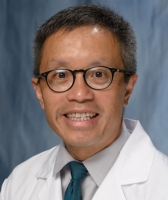
University of Florida pharmacy researchers have identified novel drug targets and a new screening method for drugs affecting the signaling pathways in colorectal cancer.
Colorectal cancer is the fourth most common cancer in the United States. Every year, about 140,000 Americans are diagnosed and more than 50,000 people die from the disease. In 2000, President Bill Clinton officially designated March as National Colorectal Cancer Awareness month to draw attention to the deadly disease.
Hendrik Luesch, Ph.D., a professor and chair of the department of medicinal chemistry and the Debbie and Sylvia DeSantis Chair in Natural Products Drug Discovery and Development, and Long H. Dang, M.D., Ph.D., an associate professor of medicine, have devised a strategy whereby multiple cancer pathways may be targeted simultaneously for drug discovery. Many of the proteins currently under investigation as possible targets for cancer therapy are found in these pathways. Their results appear in a study published in the American Chemical Society’s Chemical Biology journal.
“Cancer is characterized by simultaneous changes of multiple signaling pathways due to accumulations of mutations in key genes during cancer development,” Luesch said. “Traditionally, researchers have targeted one particular pathway that is activated in a certain type of cancer — but in the later stages of the discovery process, the drugs tested have proven ineffective.”
A signaling pathway is a group of molecules that activate each other when they need to pass along a message. In normal cells, a signaling pathway controls healthy cell growth and division, but in cancer cells, genetic mutations cause defects in the pathways. Scientists are trying to interrupt these problematic pathways in order to develop drugs to combat cancer.
“We wanted to identify key players common in multiple pathways to pinpoint more relevant cellular components considered as targets for drug discovery,” Luesch said. “Our multiplex screen has potential to target multiple pathways at once. If you do a relatively smart screen early on, you can focus on the more promising drug candidates, and that could translate into a shorter discovery and development timeline.”

The research may be applied to other cancer therapies in the future, including colorectal, pancreatic, thyroid and lung cancers.
“We could adapt this type of strategy for any cancer causing mutation, as it is a screening platform that could be extended to any gene that is a problem,” Luesch said.
Using colorectal cell lines developed by Dang, UF Health researchers studied the relationship between two crucial signaling pathways involving KRAS genes and HIF transcription factors. Mutations of the KRAS genes are present in one-third to one-half of all colorectal cancers. HIF transcription factors are proteins often linked to cancer growth. Dang generated novel colorectal cell lines called knockout cells that were depleted of either mutated KRAS or HIF proteins. Luesch screened the knockout cells against parent cells that contained mutated KRAS and HIF proteins to identify drug targets that inhibited both signaling pathways. Almost 8,000 genes in the human genome were screened to identify novel drug targets in the pathways. Scientists then exposed the cells to more than 4,700 commercially available chemical compounds and identified 55 compounds that affect cancer cell growth in both the KRAS and HIF pathways.
Next, Luesch’s team screened a subset of marine natural product compounds from a library housed at the UF Center for Natural Products, Drug Discovery and Development. These compounds were previously isolated in his lab from cyanobacteria, a rich source of bioactive molecules found in marine environments. UF scientists found two of the library’s compounds, dolastatin 10 and largazole, to be novel inhibitors of the KRAS and HIF pathways. Dolastatin 10 is a close relative of a new medicine used for the treatment of Hodgkin’s lymphoma and anaplastic large cell lymphoma, a rare type of non-Hodgkin’s lymphoma. Luesch’s lab team identified the compound in the Pacific and Atlantic oceans. Largazole was discovered in cyanobacteria collected by Luesch’s team off the coast of the Florida Keys, and it has shown characteristics of being highly effective at reprogramming cancer cells and inhibiting cancer growth.
“We have some impressive data that shows largazole decreases colorectal cancer growth in rodent models and novel cellular data that shows it prevents the development of new blood vessels,” Luesch said. “In the present study, we found that largazole inhibits HIF-induced blood vessel development in zebrafish, indicating that our cellular screens have predictive power to identify effective HIF inhibitors.”
Luesch sees this research as a starting point to screen for personalized therapies. The college’s Center for Pharmacogenomics studies how genes affect the way the body responds to medicines and identifies optimal drug therapies based upon genotype.
“We are applying a similar concept as a step toward personalized medicine by taking mutations into account during the discovery process,” Luesch said. “The more immediate benefit for colorectal cancer patients is that we have now identified compounds that could be potentially used in combination therapy to treat colorectal cancer.”

